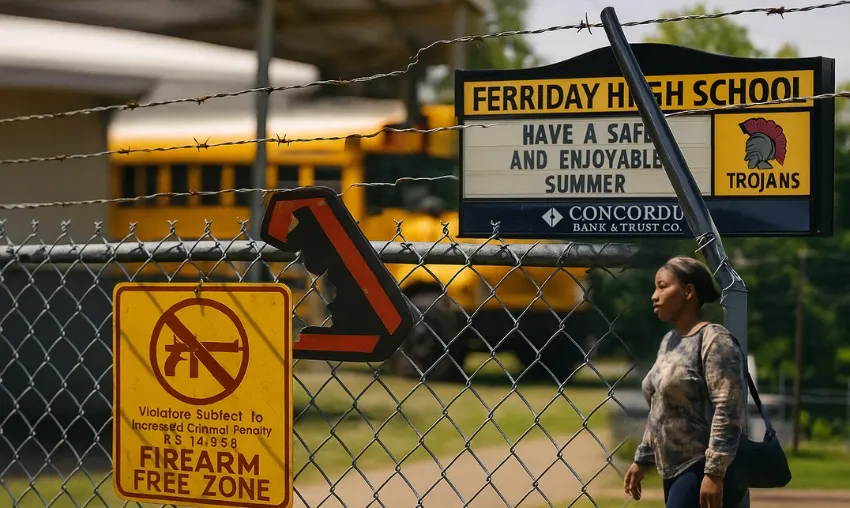It is just a country road that separates Ferriday from Vidalia – but crossing it means traveling through decades of American history. On one side: Ferriday High School, a campus fenced with barbed wire, its windows cloudy, the masonry crumbling. Ninety percent of the students here are Black. On the other side: Vidalia High School, spotless, with a modern library, fresh paint on the walls – and 62 percent of the student body is white. For Brian Davis, a father in Ferriday, the message is unmistakable: "It feels like our children are worth less."
Both schools belong to Concordia Parish in Louisiana – a district ordered to desegregate in 1965. Sixty years later, the order is still in effect. But now, Donald Trump's Justice Department wants to end it. The Civil Rights Division is headed by Harmeet Dhillon, a lawyer with close ties to the Trump camp. Her promise: The old court rulings will "fall like dominoes." What is being sold as a "relief" for school authorities is, in truth, a retreat from history. Trump's administration, cheered on by local Republican politicians, seeks to withdraw from the active enforcement of civil rights. The first victims: the children of poor, mostly Black families – like those in Ferriday.
The arguments for this move sound familiar: The old mandates are "outdated," they "burden" school districts. We must "look ahead" – a rhetorical pattern always deployed when structural inequality can no longer be denied but also won't be addressed. Yet reality tells a different story. In Concordia, the decades-old court ruling still prevents elite schools from favoring white children. It enables intervention in disciplinary disparities. It holds schools accountable. And in over 130 districts in the South, similar orders are still in effect – a legacy of the civil rights era now deliberately targeted for elimination.
Back in 2013, when the private Delta Charter School opened its doors – on the grounds of a former whites-only private school – the court stepped in: The student body had to reflect the district's ethnic makeup. Initially, only 15 percent of the children there were Black. Only through court enforcement did that number rise to 40 percent. Without the court, civil rights organizations say, such corrections would be impossible – or simply unaffordable. But that is precisely the goal: to silence the courts. What remains is a rigged playing field where structural disadvantage is declared the new normal. For many white families in Vidalia, the idea that their children might soon learn alongside those from Ferriday is an affront. At a town hall meeting in December, the resistance was loud: They didn't want "culture clashes," "drugs," or "disruptions to their environment." The equation of Black schools with danger and decay was not subtle – it was brutally explicit.
The integration plan is a stab in the back to the school system – because then white families would flee to private schools. That this amounts to a return to segregation seems to bother no one anymore.
What is unfolding here is more than a legal dispute. It is an ideological battle over the legacy of the civil rights movement. Our research confirms that at least 132 school districts in the South remain under court supervision. And now, under an administration that openly opposes diversity and inclusion, this last corrective is to be dismantled. It is the final curtain before a new form of legalized inequality. Concordia is a textbook example: The district was placed under federal oversight during the era of the Ku Klux Klan. Today, its schools reflect the racial composition of their surroundings – not because integration has succeeded, but because white families have systematically withdrawn. The move to Vidalia or to almost all-white Monterey is no accident – it is the reproduction of social division, disguised as "parental choice."
Numerous studies show: When desegregation orders are lifted, segregation rises again. Especially charter and private schools have become, in many places, the de facto successors of former whites-only schools – just without the sign on the door. At the same time, long-term studies from Stanford and Harvard show that children from integrated schools later enjoy higher incomes, more stable family lives, and lower incarceration rates – especially Black students. Education researcher Sean Reardon from Stanford University puts it plainly: "The only school districts in the U.S. where racial achievement gaps are even moderately small are those where there is little or no segregation. Every moderately or highly segregated district has large racial achievement gaps." What is being lost, then, is not just legal oversight. It is also the future.
Without a court ruling, all control vanishes. Already, Concordia is struggling to implement the court's mandates. Many lawyers in the Justice Department have resigned. The few who remain are fighting against time – and against a political wave that has once again declared the word "integration" a threat. And Ferriday? It is being left behind. In dilapidated classrooms, with broken sports facilities and a shortage of teachers. Brian Davis sums it up: "People here don’t have the means to move their children. And schools like Ferriday – they just fade into darkness."
What is happening here is not history. It is the present – and perhaps soon the future.
